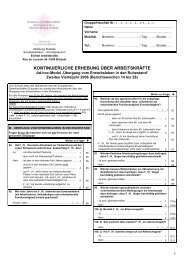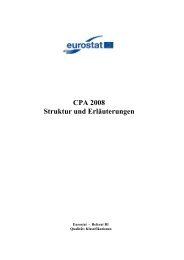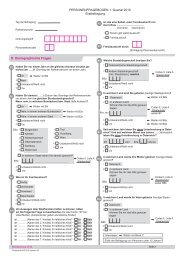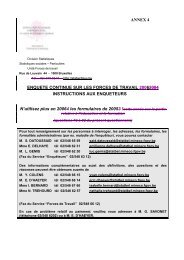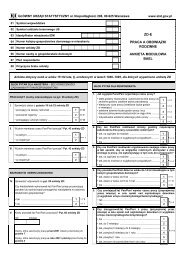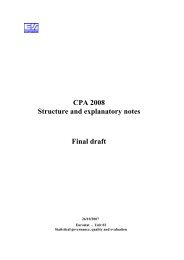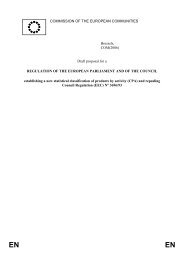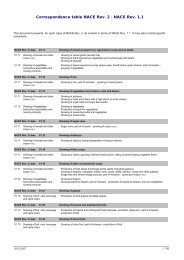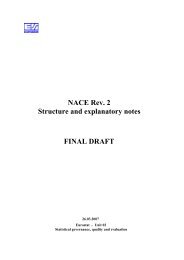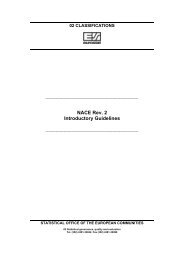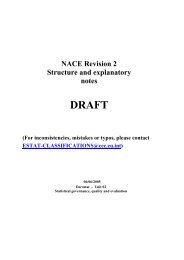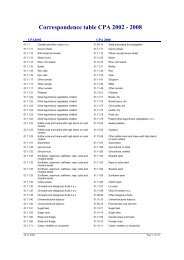RFU-CCS-067 Subset-76 - CIRCA
RFU-CCS-067 Subset-76 - CIRCA
RFU-CCS-067 Subset-76 - CIRCA
You also want an ePaper? Increase the reach of your titles
YUMPU automatically turns print PDFs into web optimized ePapers that Google loves.
RECOMMENDATION FOR USE<br />
CO-ORDINATION BETWEEN NOTIFIED BODIES<br />
DIRECTIVE 2008/57/EC AND SUBSEQUENT<br />
AMENDMENTS ON THE INTEROPERABILITY OF THE<br />
RAIL SYSTEM WITHIN THE UNION<br />
TITLE<br />
RECOMMENDATION FOR USE<br />
<strong>RFU</strong>-<strong>CCS</strong>-<strong>067</strong><br />
Issue 01<br />
Date 05/10/2012<br />
Page 1 of 4<br />
ERTMS/ETCS ON-BOARD HAS TO PASS THE FULL TESTS SEQUENCES OF SUBSET-0<strong>76</strong>-5-2<br />
AND SUBSET-0<strong>76</strong>-6-3<br />
ORIGINATOR SUBJECT RELATED TO<br />
BELGORAIL, RAILCERT B.V. 2012/88/EU §6.2.4.1<br />
SUBSET-0<strong>76</strong>-5-2, SUBSET-0<strong>76</strong>-6-3<br />
DESCRIPTION AND BACKGROUND EXPLANATION<br />
Manufacturers of the Interoperability Constituent (IC) ERTMS/ETCS ON-BOARD expect<br />
to have problem with the application of section 6.2.4.1 of new <strong>CCS</strong> TSI (2012/88/EU).<br />
In the previous TSI <strong>CCS</strong> the use of <strong>Subset</strong>-0<strong>76</strong> for IC ERTMS/ETCS ON-BOARD testing<br />
was a basic part to demonstrate the conformity, but not limited to these test sequences<br />
only. In fact the IC ERTMS/ETCS ON-BOARD verification and test activities were<br />
primarily carried out by reference to <strong>Subset</strong>-026 (SRS) in combination with <strong>Subset</strong>-0<strong>76</strong><br />
Test requirements.<br />
Section 6.2.4.1 of the new <strong>CCS</strong> TSI (2012/88/EU) requires that the Notified Body shall<br />
check that a specimen of the interoperability constituent has passed the full set of<br />
mandatory test sequences referenced in <strong>Subset</strong>-0<strong>76</strong> and that these tests were carried<br />
out in an accredited laboratory 1 .<br />
Since the <strong>Subset</strong>-0<strong>76</strong> is very complex, it may still originate erroneous test results.<br />
Some errors are not really errors, but they may be identified as such. This because the<br />
configurations/options used when creating test cases or test sequences may differ<br />
from those being implemented by a specific supplier, e.g. due to presences of designer<br />
choices, different parameter settings, optional SRS requirements, different interface<br />
implementation, etc.. This difficulty is not originating from the <strong>Subset</strong>-0<strong>76</strong>, but a<br />
consequence of the variety and range of options and configurations intentionally<br />
permitted by the specifications.<br />
Although it is very much appreciated and acknowledged that <strong>Subset</strong>-0<strong>76</strong>, test<br />
sequences as well as the relevant test procedures have been extensively improved in<br />
the last two years (e.g. with view to the not yet fully published <strong>Subset</strong>-0<strong>76</strong> v2.3.3),<br />
residual test problems may still persist, e.g. because of uncontrolled implementation of<br />
Change Requests, due to divergent SRS interpretation or the application of the Test<br />
Sequence Debugger Tool that is used by the laboratories as reference.<br />
1 Accredited to carry out this type of tests in accordance with Regulation (EC) No <strong>76</strong>5/2008 of the European<br />
Parliament and of the Council of 9 July 2008 setting out the requirements for accreditation and market<br />
surveillance relating to the marketing of products and repealing Regulation (EEC) No 339/93.
RECOMMENDATION FOR USE<br />
CO-ORDINATION BETWEEN NOTIFIED BODIES<br />
DIRECTIVE 2008/57/EC AND SUBSEQUENT<br />
AMENDMENTS ON THE INTEROPERABILITY OF THE<br />
RAIL SYSTEM WITHIN THE UNION<br />
RECOMMENDATION FOR USE<br />
<strong>RFU</strong>-<strong>CCS</strong>-<strong>067</strong><br />
Issue 01<br />
Date 05/10/2012<br />
Page 2 of 4<br />
The return of experience of the already carried out tests in accredited laboratories<br />
evidently shows that until today no IC ERTMS/ETCS ON-BOARD has passed the full set<br />
of tests without objections even if compliance with <strong>Subset</strong>-026 had been<br />
acknowledged.<br />
A more exhaustive and commonly agreed assessment guide could be very useful.<br />
Therefore, NB-Rail has identified at least the need for a common approach to be<br />
applied by the notified members with regard to the following aspects:<br />
1. Conduction of tests in an accredited laboratory;<br />
2. Evaluation of not passed test sequences.<br />
Note that according to chapter 6 of the <strong>CCS</strong> TSI (2012/88/EU), the tests of <strong>Subset</strong>-0<strong>76</strong><br />
are not the only verifications that need to be performed for demonstrating conformity of<br />
an IC ERTMS/ETCS ON-BOARD. E.g., the safety verification and validation process<br />
(RAMS aspect / Table 6.1) is another important step in the process. Where referenced<br />
in the <strong>CCS</strong> TSI, other type of tests are requested, e.g. transmission and protocol tests,<br />
assessment of time and position accuracy performances, tests for safety proof,<br />
realistic test scenarios, etc.. This in turn may enable to evaluate the errors that are<br />
found whilst conducting <strong>Subset</strong>-0<strong>76</strong> and define appropriate corrective actions.<br />
In any case the Notified Bodies are asked to contribute actively to the continuous<br />
improvement of the test procedures and relevant facilities by collecting and sharing<br />
experience at the level of NB Rail in the modes that will be agreed within the ERTMS<br />
SG.<br />
<strong>RFU</strong> PROPOSAL<br />
1. Conduction of tests in an accredited laboratory<br />
Regardless of whether module CB or CH1 is chosen, the Notified Body shall check<br />
that a specimen of the interoperability constituent (or group enclosing it) has passed<br />
the full set of mandatory test sequences and that these tests were carried out in an<br />
accredited laboratory.<br />
With regard to the responsibility of Notified Bodies, the need and degree for direct<br />
involvement and/or presence whilst conducting the tests in an accredited laboratory, is<br />
to be decided by the individual Notified Body and shall be agreed in advance with the<br />
applicant and the accredited laboratory.<br />
If the tests were not carried out in an accredited laboratory, the notified body shall
efuse to issue a certificate.<br />
RECOMMENDATION FOR USE<br />
CO-ORDINATION BETWEEN NOTIFIED BODIES<br />
DIRECTIVE 2008/57/EC AND SUBSEQUENT<br />
AMENDMENTS ON THE INTEROPERABILITY OF THE<br />
RAIL SYSTEM WITHIN THE UNION<br />
RECOMMENDATION FOR USE<br />
<strong>RFU</strong>-<strong>CCS</strong>-<strong>067</strong><br />
Issue 01<br />
Date 05/10/2012<br />
Page 3 of 4<br />
If the tests were carried out in an accredited laboratory, the Notified Body shall take<br />
this into account with view to the module chosen by the applicant for assessing the<br />
interoperability constituent.<br />
If module CH1 is chosen the notified body is not responsible for the execution of<br />
the tests, only for the assessment of the quality management system applied for<br />
the tests and the use of the test results in the conformity assessment and<br />
verification. The quality of these test results are considered covered by the Quality<br />
Management System of the manufacturer/contracting entity, being an integral part<br />
of module CH1 conformity assessment.<br />
If module CB is chosen by the applicant, this should be considered by the notified<br />
body.<br />
In case of changes or modification to an already tested/certified IC ERTMS/ETCS ON-<br />
BOARD, regression tests performed by the accredited laboratory may cover the delta<br />
only, if justified and found feasible. The extent of regression testing can be defined by<br />
the NoBo (module CB) or the applicant in collaboration with the accredited laboratory<br />
(module CH1), but shall always be agreed and acknowledged by the Notified Body<br />
before conduction.<br />
2. The ‘non-passed’ tests<br />
Basically <strong>Subset</strong>-0<strong>76</strong>-6-7 provides a set of rules (applicable guideline for the<br />
laboratories) how test sequences must be evaluated and indicates the validation<br />
ranges applied when testing an IC ERTMS/ETCS ON-BOARD. Besides the subset<br />
describes the way in which test sequences have been agreed to be written in the Test<br />
Specification Work Package.<br />
On the Basis and criteria set out in <strong>Subset</strong>-0<strong>76</strong>-6-7 the accredited laboratory will be in<br />
charge to classify all steps of all the sequences belonging to <strong>Subset</strong>-0<strong>76</strong> as passed or<br />
non-passed. The non-passed steps of the test sequences shall first be analysed by the<br />
NoBo (module CB) or the applicant in collaboration with the accredited laboratory<br />
(module CH1).<br />
In any case, for the evaluation of the overall test results, <strong>Subset</strong>-026 (subject to the<br />
official ERA interpretation of identified ambiguous requirements) shall prevail over any<br />
other subset, including the test specification itself. Therefore it remains the duty of the<br />
Notified Body to perform final evaluation of non-passed test cases keeping this general<br />
principle in case of any deviation or contradiction.
RECOMMENDATION FOR USE<br />
CO-ORDINATION BETWEEN NOTIFIED BODIES<br />
DIRECTIVE 2008/57/EC AND SUBSEQUENT<br />
AMENDMENTS ON THE INTEROPERABILITY OF THE<br />
RAIL SYSTEM WITHIN THE UNION<br />
RECOMMENDATION FOR USE<br />
<strong>RFU</strong>-<strong>CCS</strong>-<strong>067</strong><br />
Issue 01<br />
Date 05/10/2012<br />
Page 4 of 4<br />
The final evaluation by the Notified Body may lead to the identification of<br />
complementary tests to be performed (by the applicant or the accredited laboratory) in<br />
order to get ultimate evidence of conformity, in particular for the functions not<br />
demonstrated compliant by conducting the tests sequences in the accredited<br />
laboratory, but by supplemental test or alternative verification results.<br />
11 October 2012 at PM 36<br />
DATE OF AGREEMENT AT NB RAIL PLENARY MEETING



